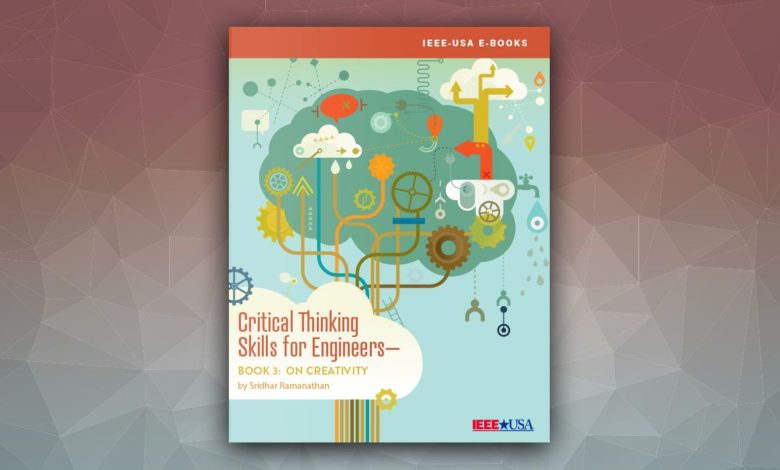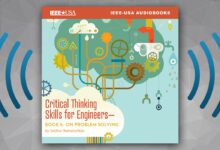
Creativity is often considered the core of engineering, because it is what allows technical professionals to find the solutions to society’s challenges. But San Francisco consultant Sridar Ramanathan believes that without self-awareness and some preliminary effort, thinking creatively can be a stumbling block for engineers.
“Creativity demands that we suspend disbelief, put aside practicality, let go of judgments coming from yourself and others, and overcome the fear of being wrong and appearing stupid,” he says. “Engineers are trained to be problem solvers and rational thinkers, and they rarely feel comfortable taking such risks — especially in front of peers.”
To help engineers overcome behaviors that can block creativity, the newest volume in Ramanathan’s e-book series on critical thinking offers strategies that can lead to valuable, innovative solutions.
Published in 2019, Books 1 and 2, focus on analytical skills and communication. They also are available from IEEE-USA Publishing. This newest book — Book 3 — is full of ideas to stimulate fresh thinking. In it, the author discusses nine different approaches to fueling creativity — ranging from divergent and convergent thinking to cognitive flexibility and visualization.
Familiar to most people, brainstorming is actually an example of divergent thinking. This technique aims to generate as many ideas as possible for solutions to a given problem. Another type of divergent thinking, bisociation connects two seemingly unrelated things that result in a significant new idea. For example: Gutenberg combined a wine press and a coin punch to create the first printing press; much more recently, Steve Jobs brought together a tablet PC computer and a cell phone to produce the iPhone®.
On the other hand, convergent thinking requires clear objectives and criteria for assessing ideas. Among the possible measures: potential for mass adoption, purchase price, the novelty factor and ease of replicating at scale. The idea with the highest weighted score would be the best one to take forward to product validation testing and even possible commercialization.
Ramanathan explains that cognitive flexibility relates closely to divergent and convergent thinking.
“People who can successfully switch between contexts or tasks have greater cognitive flexibility; and therefore, are likely to learn more quickly, adapt more rapidly to new situations, and solve problems creatively,” he writes. He suggests several techniques for readers who want to stretch their cognitive flexibility, including:
- Develop a new skill. Learning a new language helps improve the memory, as well as help one be more cognitively creative and mentally flexible.
- Change a daily routine. For example, use a different hand to brush your teeth — it can help to adapt to new contexts.
- Establish a regular exercise program. For as little as 20 minutes each time, a few times each week, a cardio fitness program can improve cognitive performance, especially cognitive flexibility. The so-called “flow state,” in which the mind is simply present with how your body is feeling as you exercise, is conducive to creativity.
The author points out that visionary thinkers — those with forward, progressive ideas and who inspire others to adopt their vision — all share three common characteristics: whether that person is a Jeff Bezos (Amazon) or a Marissa Mayer (Yahoo!), he or she does these three things:
- listens actively,
- shows rather than tells, and
- connects disparate ideas.
For Ramanathan, an active listener pays close attention to customers, users, colleagues and other partners who might help to shed light on the need. Because he or she is fully engaged with people, it’s easy to ask “why” at each level of the inquiry and get to the heart of the engineering problem at hand.
When showing instead of telling, the visionary thinker uses an image — a 3D printed prototype, a video or even a simple stick-figure sketch — to help convey an idea. Articulating your idea in a visual way helps to build a vision that others will share.
Finally, visionary thinkers tend to connect very dissimilar ideas or concepts into a completely different context. Jeff Bezos, for example, applied internet e-commerce to the long-established business model of retail book selling; in doing so, he created an online bookstore that is now a giant in e-commerce, cloud computing and more. The author suggests trying this by seeing how a given technology area might be applied in a completely different contest, or how a completely different discipline could be brought in to solve your engineering challenge.
IEEE-USA is introducing Critical Thinking for Engineers – Book 3: On Creativity, beginning 1 June. It is free to IEEE members in the IEEE-USA Shop. Non-members pay $4.99.
Ramanathan is planning two more volumes in this e-series on Critical Thinking for Engineers. The next one will be about the need to be open-minded — putting aside any pre-conceived notions and assumptions, and simply analyzing the information at hand.
Sridar Ramanathan has 30 years of experience in technology companies, ranging from startups to blue-chip firms. As managing director and co-founder of Aventi Group, he has been instrumental in leading many high-tech organizations through high growth phases. Prior to co-starting Aventi Group, he was the marketing executive for Hewlett-Packard’s Managed Services business. He has an MBA from the Wharton School of Business and a B.S. in Engineering Physics from the University of California, Berkeley.
Helen Horwitz is an award-winning freelance writer who lives in Albuquerque, N.M. She was with IEEE from 1991 through 2011, the first nine as Staff Director, IEEE Corporate Communications.






